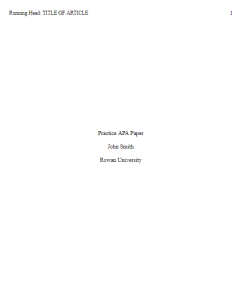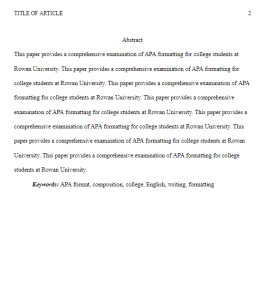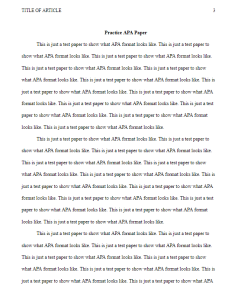23
Key Concepts
- APA format, also known as the American Psychological Association style, is a citation and formatting style most researchers use.
- Students will likely use APA format in upper-level classes when writing papers.
- Purdue Owl is a fantastic resources for all information related to APA format.
- APA formatted papers include a Title Page, Abstract, Main Body, and References page.
- All APA formatted papers should be double-spaced and in 12 point font.
APA format, also known as the American Psychological Association style, is a citation style developed by a group of researchers as a guide to format papers. In many of your upper level classes, you will use this format when submitting papers or publishing research.
Citing sources can get tricky, which is why the library has several tools to help you make it as easy as possible. If you need to create citations with a citation generator and keep track of them in folders, get an account with RefWorks: go.rowan.edu/Refworks
If you need help understanding APA format better or help creating citations for formats not in RefWorks, APA Academic Writer has the entire APA manual for you to review: go.rowan.edu/APAacademicwriter
In general, Purdue Owl is a fantastic up to date resource for everything you need to know about APA formatting. As style guidelines tend to change frequently, it’s important to double check that any old guidebooks still have accurate information.
The following chapter explores the basics of APA formatting, including formatting the References page, citing in-text, and formatting an APA-style paper.
While it’s absolutely fine to use a citation machine for you, it’s invaluable to understand on your own what a proper APA citation should look like. Purdue Owl always has up to date information on citation styles and answers any question you might have about APA format.
In general, for most standard articles, you will fill out the information below with your source’s information:
Muhammad, K. R. (2015). Everyday people: Public identities in contemporary hip-hop culture.
Social Identities, 21(5), 425-443. doi:10.1080/13504630.2015.1093467
Author(s): Last name and Initials of the first and middle name ONLY
Your references page should be in alphabetical order, starting with the first letter that appears in each citation (this isn’t always the author’s last name).
- You should use hanging indentations on your references page.
- Use a page break after the end of your essay and before your references page. To do this:
- Once you get to the end of your essay/conclusion, finish it with a period.
- Then hit either control+enter (windows) or command+enter (Mac) at the same time. This should work on Word or Drive. You can also typically go to “Insert” and then “Page Break” or “Break” then “Page Break”
The tools mentioned above will also help you with in-text citations. In-text citations are when you give appropriate credit in the body of your work. There are a few ways to do that and the Purdue OWL APA General Guidelines can also help you figure it out. If you name the author in the sentence, then you put the publication year in parentheses directly after their name. If you do not use the author’s name, then at the end of the sentence in parentheses you add the authors name followed by the publication year. Then in the parenthetical you just write the page (p.)/paragraph (para.) number. Remember to put any direct quotes in quotation marks and include page numbers! Every idea that is not your own including direct quotes, paraphrasing, or summarizing needs to be cited.
Here are some examples:
Muhammad (2015) takes time to find differences in five subgroups of hip-hop culture.
OR
There are five subgroups in hip-hop culture (Muhammad, 2015.)
OR
According to Muhammad (2015), “Hip-Hop Fundamentalists are highly critical of the way that hip-hop has evolved away from principles associated with collective, political activism” (p. 431).
- Your paper should be in 12 point font, with 1″ margins on all side. APA recommends using Times New Roman.
- Your paper has four sections: Title Page, Abstract, Main Body, and References.
- Your title page gets its own heading that says “Running Head: TITLE OF PAPER” in the top left corner.
- Subsequent pages will just get “TITLE OF PAPER” — still on the top left.
- Your title page also gets the title of your paper, your name, and your university completely centered.
- All pages, including the title page, should have a number on the top right.

- The second page should get an Abstract.
- Abstract should be centered at the top of the page, and your abstract should be left aligned with no indentation.
- After your abstract, you should have a line for keywords, which will be italicized, followed by non-italicized keywords.

- The first page of your actual paper (now your 3rd page) will get a title at the top.
- All subsequent paragraphs will be indented .5 inches.
- All text should be double-spaced, with no extra space between paragraphs.

See an example of an APA formatted paper here.
